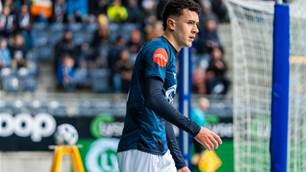The 23-year-old, who spent four months this winter on loan to Chinese club Tianjin Teda, has thrived under Lavicka’s leadership.
The 23-year-old, who spent four months this winter on loan to Chinese club Tianjin Teda, has thrived under Lavicka’s leadership.
 Mark Bridge Sydney FC. Image: Warren Clarke
Mark Bridge Sydney FC. Image: Warren ClarkeAfter last year’s A-League failure, Sydney FC took a different approach. Rather than outlaying for a creaking marquee player, they sought out a marquee coach instead. And so Vitezslav Lavicka, a 46-year-old Czech with a resume headed by stints at Sparta Prague and Slovan Liberec, headed south to the Harbour City. His no-nonsense, Eastern bloc mentality has promptly kiln-fired Sydney this season.Who better to dissect Lavicka’s training ground dictatorship than striker Mark Bridge? The 23-year-old, who spent four months this winter on loan to Chinese club Tianjin Teda, has thrived under Lavicka’s leadership. For evidence, look no further than the 26th minute of Sydney’s round seven clash with Newcastle. Bridge collected the ball 45m from the Jets’ goal, two defenders in front of him. He burnt the first on his outside shoulder, turned the second inside out, then cracked a right-foot drive that climbed and curled over the keeper’s head before dipping neatly into the top left corner. It was a sublime show of individual skill that must’ve widened the eyes of national manager Pim Verbeek.
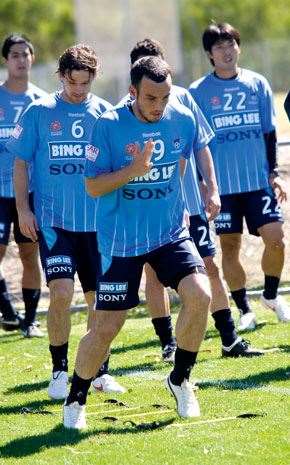 The ladder is a great agility tool. Image: Warren Clarke
The ladder is a great agility tool. Image: Warren ClarkeGetting started
“We do a V02 max test at the start of the season. It tells us where our heart rate’s at, its maximum and where it peaks. From then on, when we’re going to do a hard session, we wear heart rate watches at training. Our trainer wants us hitting 80 per cent of our max heart rate. That shows him we’re working. When we stop, the quicker that heart rate drops, the fitter we are. We’re aimingto get our heart rate up to 175 and we want to get it back to 120 in around a minute. That’s a realistic time; any shorter than that and you’d be massively fit. We normally have a quick drinks break after we’ve done a hard, small-sided game and by the time we’ve finished the break and walking back onto the field, our heart rate should be hitting that 120 mark. All the boys are around that atthe moment – we’re a pretty fit squad.”
Match Fit
“We have a very long pre-season – most of our aerobic work is done there. By the time we hit the season we’re not doing too much fitness stuff, we’re basically just ticking over. We play games, particularly small-sided games to maintain that match fitness. You know, matches are a lot different to training. If you’re training alone you don’t have that intensity – someone marking you, small changes of direction, start-stop sprints, longer 50m sprints to counter attack. There are so many different types of sprinting involved in a game situation.
“I think the best exercise you can do to get close to match fitness is fartlek running – jog for 20m, sprint 20, jog 20, sprint 40 and so on. But I definitely think the more matches you play in pre-season the easier it is when you come to the start of the season. I actually missed four months of this pre-season because I was playing in China, but I know the boys played lots of games – I think it was 13 or 14. That was a massive part of our pre-season this year. People talk about luck during the season, about things falling their way. I think the fitter you are, the luckier you get.”
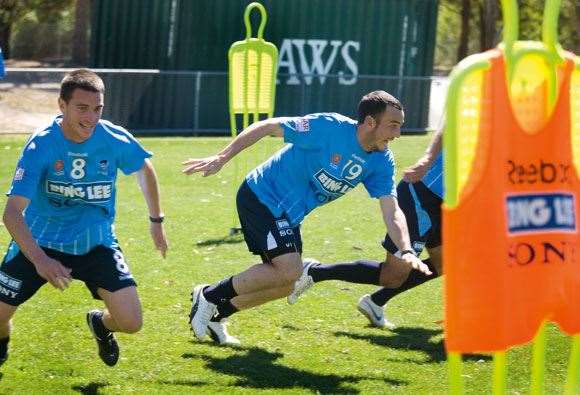 Training alone lacks the intensity of a full-squad session. Images: Warren Clarke
Training alone lacks the intensity of a full-squad session. Images: Warren ClarkeGetting warmer
“In our normal warm-up routine we start with glut exercises. We wrap a theraband around our ankles, then we’ll do ten lifts to the side, ten forward, ten back, walking forward, walking to the side etc. After that we pass the ball around, pretty relaxed, just mucking around. Then we’ll run two laps, very slowly, just to get the legs moving and the heart rate up. After that we do a light stretch, all the basic exercises – legs over, knees up, straight leg etc. Then we’ll do a couple of short sprints, not full pace but lifting
the heart rate. After that we get into groups of six, passing the ball around, staying on the move, no one’s allowed to be walking. Then we’ll do some squatting exercises and leg swings, just activating the leg muscles.”
Fast feet
“We do a lot of fast feet drills. We use ladders or mannequins or poles and you have to get through the course, in and out, like a slalom. All the courses are over 10 or 20 metres – really short, sharp, explosive. Sometimes we do a ‘fun’ fast feet exercise where a pair of players jog to the middle of four coloured mannequins and the trainer calls out a colour and one of you has to sprint to the coloured mannequin while your mate sprints to the opposite one. It’s about running and thinking at the same time. We particularly do a lot of fast feet work the day before a game. It’s all to get our feet moving in that final session.
“The coaches are trying to bring a lot of ballwork into these drills. When you think about it, it makes sense given we spend most of our time running with the ball at our feet. It’s important because it makes controlling the ball second nature in the game. At the moment they’re getting us to look ahead rather than looking down at our feet as we’re running through the courses with a ball. If people are going to be tackling us, we don’t want to be looking at our feet – we want to be watching who’s coming at us and from what angles.”
Drilled
“We work heaps of drills. Today, for example, we did an attacking-shape drill with shooting involved. We had two mannequins as central defenders and two strikers up. And we were practising playing one striker on the ball with the other striker doing a dummy and peeling around the side of the mannequins. It’s the old Andy Cole and Dwight Yorke trick where someone would play them in while the other would dummy and run around. We were working on that, getting our movement right at the edge of the box, playing it in firm, little touch to the other striker, he finishes just inside the box.
“Another drill we did today was to have two people on each sideline, they do a little one-two, and then we have two strikers in the middle who do a simple crossover. It’s all about working movement inside the box, making sure you hit the target. Those two drills will be going on at the same time, the team in two groups at opposite ends of the field. After 20 minutes we swap over. Once we’ve done both drills, we’ll normally go into a small-sided game, taking those skills we’ve been working on into a match scenario.”
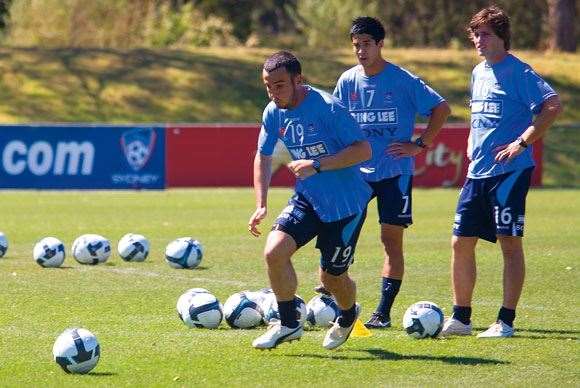 Running with the ball becomes second nature. Image: Warren Clarke
Running with the ball becomes second nature. Image: Warren Clarke
Recovery
“We’re at an age now where we are all professional enough to do our recovery ourselves. So if our bodies are sore we go in for some hot-cold treatment or throw on the compression garments. Most of the time we have masseurs at training who give us a light rub and work the soreness out of our legs. We also do yoga, normally twice a week. It’s a massive help – a couple of the older boys are always saying they wished they had yoga when they were younger. After a hard yoga session you feel a bit sore but the next day you feel amazing. It really works that heavy soreness out of your legs.
“Most of the boys are pretty good with their diet. We have lunch as a team each day and that just has your basic pasta and salads with either chicken or steak. Some of the boys take supplements before the game, just as an energy thing. After a particularly hard session we’ll have high protein recovery shakes waiting for us in the sheds.”
Playing the mind
“As a player, when you get the ball you have to know where you’re going to go next. You have to think, ‘If I’m going to get the ball from this person, I have to play it to that person.’ That forethought means you’re not losing possession, not getting caught with the ball at your feet. As a striker you need to think, ‘Okay, if I get the ball here, can I shoot first time? Where’s my body in relation to the goals? Where’s the defender standing? Can I hit it first time? Or do I need to take a touch first and hit it around him?’ If you drill little questions like these into your head at training, then they become second nature during the game. That’s how you look like a sharp-shooter!
“But, as a striker, the first question that comes into your head has to be, ‘Can I score?’ If you can’t score, okay, lay it off. When you lay it off, get in the box and get in a good area so you can knock-in those easy goals.
“Any striker will tell you that they’ve had those games, those training sessions, where no matter how hard you train, the ball’s not going to go in for you. But if you do the basic stuff right at training – get yourself into good positions, find your range before you start whipping them in – then eventually you’ll get the easy tap in and that gets the confidence back up.”
Confidence tricks
“Striker’s a hard role because it’s a confidence position. If you’re low on confidence you can make it very hard on yourself. You just have to keep doing the basic stuff right. For example, look at ‘Brosquey’ (Sydney FC striker Alex Brosque) – he hasn’t scored yet this season. But he’s been playing brilliantly. He’s been doing everything right – except score. He hasn’t been missing opportunities; things just haven’t fallen for him yet. But he’s still doing the basic things right.
“As a striker you have to think, ‘If I’m not scoring, I can still play a big part in the team. I can still run to help my team defend or lay it off in the box for someone else.’ You have to keep grinding away, keep running, keep doing the simple things right. Sooner or later it’s going to come. You can’t think to yourself, ‘Okay I’m not scoring, the manager’s angry with me, I’m a bad player.’ You’re not a bad player. Everyone goes through those patches. Just grind away.”
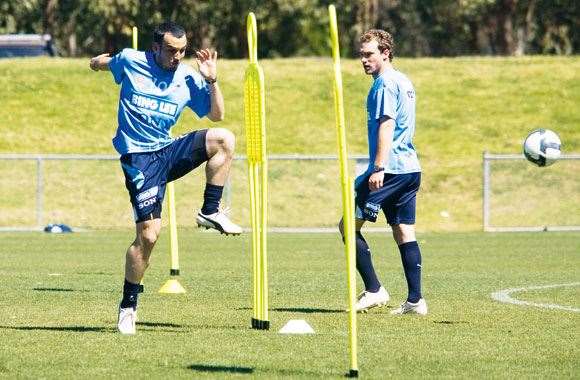 Slalom training with the mannequins. Image: Warren Clarke
Slalom training with the mannequins. Image: Warren ClarkeLooking east
“The training in China is far stricter. They go into camp each morning and they’re there all day, often until late at night. I don’t think the coaches trust their players to be out at night like Australian coaches do. Out here we have a lot of input into the training sessions. We’re always told, ‘If you have a problem, if you think we can do something better, then suggest it at a video session. If you’re right we’ll go with it, if you’re wrong we’ll move onto the next thing.’ Over there you don’t have that option. If you’re not happy with things, too bad. You’re just a player and you do what you’re told.
“The players in China have two sessions every day and they don’t do any weight training or anything like that. Their training sessions are primarily passing drills and speed drills, while over here the emphasis is much broader – shooting, crossing, fitness … They’re pretty confident when it comes to shooting over there. I think they all think they can shoot – including the goalkeeper! Overall I’d say Australians are fitter and stronger, while the Chinese are sharper and faster.
“I think going to Asia and playing there is a very worthwhile experience. Even if you only go for a short time – I was only in China for four months – you see the professionalism over there. It’s definitely your full-time job. You’re in camp 24-7 and all that’s on your mind is football. Over here, on the other hand, we’re done by one o’clock. That’s not saying we don’t work as hard, but over there it’s so … full on. You’re always there, even if you’re not training you’ll be in a room, thinking about football, or in a meeting talking about football.”
– Aaron Scott
Related Articles
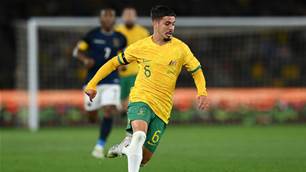
Tilio eyes A-League return in bid to escape Celtic rut

Champion A-League coach set to join Premier League giants
